
I am not a competitive shooter, which means I am not qualified to comment on the CZ 75 Shadow T-SA’s performance within that context. In fact, anyone much below a national champion would be commenting on their own shooting skills rather than the Shadow’s potential… except on Facebook, where firearm ownership and/or experience, ahead of rendering expert opinion, is a novel concept.
Why I never liked the Beatles…
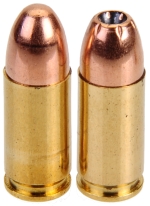 Shooting the CZ 75 Shadow was an enjoyable experience. Right up there with watching the NY Giants beat Dallas, Build Your Own Burger Night at Friendly’s and watching “Trading Places”… again. It doesn’t kick much, it doesn’t generate a lot of muzzle blast, its magazine holds a two handfuls of ammo, and it is consistently accurate, even with factory ammo like the PMC Bronze, 115 grain FMJ and JHP ammo pictured right.
Shooting the CZ 75 Shadow was an enjoyable experience. Right up there with watching the NY Giants beat Dallas, Build Your Own Burger Night at Friendly’s and watching “Trading Places”… again. It doesn’t kick much, it doesn’t generate a lot of muzzle blast, its magazine holds a two handfuls of ammo, and it is consistently accurate, even with factory ammo like the PMC Bronze, 115 grain FMJ and JHP ammo pictured right.
The Shadow is not a fussy autoloader; it feeds SAAMI spec factory and handloaded ammo, it shoots the same, then ejects empties without incidence. Sights are… crisp and the red light pipe front sight stands out against basically any background. Sight adjustment is detented micro click and adjustments stays put. Take down is quick and required no tools. Quality finish of materials makes clean up is easy.
Four good handloads… almost
The only other ammunition that was included in the live fire exercises was Winchester white box FMJ 115 grain and the 4 handloads shown below. Again, not a competitive shooting scenario, just recreational target shooting and potentially self defense ammunition.
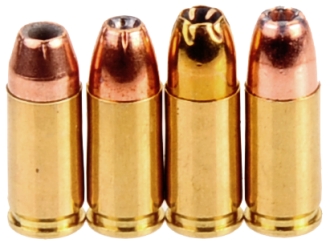
A while back, after conducting a large scale penetration test on short barrel autoloaders in 380 ACP, 9mm Luger and 357 SIG, and finding many popular bullets didn’t expand and/or over penetrated, the 4 combinations pictured left became preferences. They represented the best combinations of bullet expansion, penetration and weight retention.
Left to right order – 115 grain Sierra Sports Master JHP, 115 grain Winchester JHP-Notched, 124 grain Remington Golden Saber, 47 grain Speer Gold Dot.
| Brand | Weight Grains |
MV fps |
Retained Weight |
Expanded Diameter “ |
Depth” |
| Sierra | 115 | 1191 | 114.8 | 0.460 | 12 |
| Winchester | 115 | 1236 | 114.0 | 0.636 | 6 |
| Rem GS | 124 | 1219 | 121.4 | 0.602 | 6 |
| Speer | 147 | 1013 | 147.0 | 0.356 | 11 |
| Impact 10′ from muzzle | |||||
The table above represents the original expansion-penetration test results. Velocity differs from handloads listed below; different time, place and firearm. All, with the exception of minor tweaking, are consistent with component manufacturer’s data. Care is required when loading the 115 grain Sierra Game King. The bullet’s shank is 0.355″ and comes relatively far forward into the chamber while providing the least net powder capacity.
Warning: Bullet selections are specific, and loads are not valid with substitutions of different bullets of the same weight. Variations in bullet length will alter net case capacity, pressure and velocity. Primer selection is specific and primer types are not interchangeable. These are maximum loads in my firearms and may easily be excessive in others. All loads should be reduced by 5%, and developed following safe handloading practices as represented in established reloading manuals produced by component manufacturers. Presentation of these loads does not constitute a solicitation for their use, nor a recommendation.
|
Cartridge: 9mm Luger |
|
| Rifle: CZ 75 Shadow T-SA | Max COL: 1.169″ |
| Bullet Diameter: 0.355″ | Primer: CCI 500 |
| Barrel: 4.720″ | Reloading Dies: RCBS |
| Max case length: 0.754″ | Group distance: 25 Yards |
| Bullet |
Bullet Weight Grains |
Net Water Capacity H2O |
COL” | Powder Type |
Powder Charge Grains |
Muzzle Velocity FPS |
Muzzle Energy Ft-Lbs |
3 Shot Group “ |
|
| Sierra Sports Master | 115 | 8.1 | 1.050 | AA 7 | 8.4 | 1183 | 357 | 1.2 | |
| Sierra Sports Master | 115 | 8.1 | 1.050 | HS 6 | 6.7 | 1177 | 354 | 2.4 | |
| Winchester JHP-N | 115 | 8.3 | 1.090 | AA 7 | 8.5 | 1196 | 365 | 1.1 | |
| Winchester JHP-N | 115 | 8.3 | 1.090 | Power Pistol | 6.5 | 1258 | 404 | 1.2 | |
| Remington GS | 124 | 8.4 | 1.135 | AA 7 | 8.2 | 1147 | 362 | 1.6 | |
| Remington GS | 124 | 8.4 | 1.135 | Power Pistol | 6.0 | 1176 | 381 | 1.4 | |
| Speer GD | 147 | 6.3 | 1.130 | AA 7 | 6.1 | 831 | 225 | 0.8 | |
| Speer GD | 147 | 6.3 | 1.130 | Unique | 4.3 | 913 | 273 | 2.1 | |
| Speer GD | 147 | 6.3 | 1.130 | Power Pistol | 5.0 | 1027 | 344 | 1.3 | |
| Factory Ammunition | |||||||||
| PMC Bronze FMJ | 115 | – | – | – | – | 1155 | 341 | 1.7 | |
| PMC Bronze JHP | 115 | – | – | – | – | 1131 | 327 | 1.4 | |
| Winchester | 115 | – | – | – | – | 1161 | 344 | 1.5 | |
Holes in paper…
The assessment of this handgun’s accuracy is found in the smallest groups, because they could be repeated. The larger groups are a function of dialing in ammunition and shooter performance.

In regard to the Shadow’s mechanical accuracy, the clips of targets above were shot from a steady rest, slow fire, at 25 yards. For shooters who have the skill, not for guys like me who have to rely on a rest and 100 pounds of sandbags to get these results, the accuracy is in the gun waiting for a skilled shooter to bring it out. Above, from left to right: Sierra 115 grain Sports Master handload, the middle is PMC Bronze 115 grain and the last is a 147 grain Speer Gold Dot moderate velocity handload.
Poke and shoot? No rest for the weary…
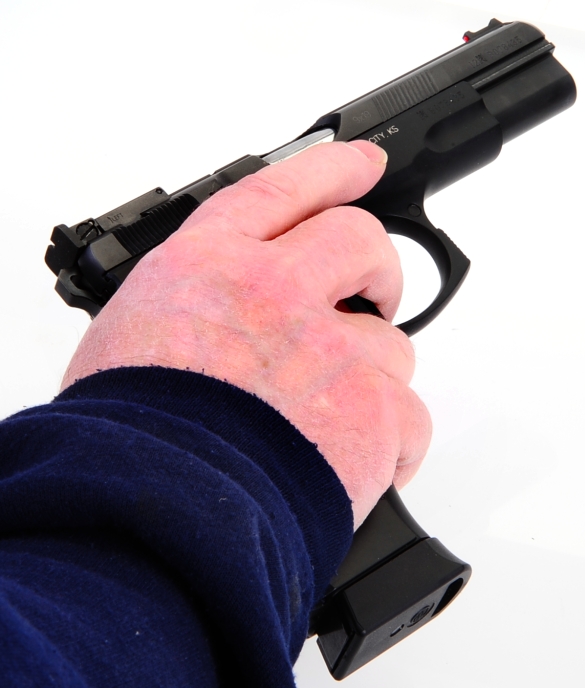
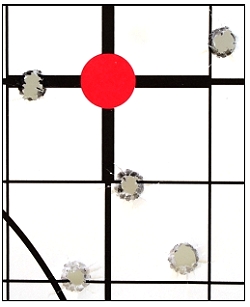
I figured since most experts have deemed point shooting passé… that’s French you know, it would be a good time for me to write about the technique and to see how well the Shadow would shoot without external support and without taking all of the time in the world. The rearward placement of the flat trigger lent itself to positioning the index finger on the frame and the middle finger on the trigger. The grip was strong enough to hold the gun securely, even if it felt a little odd. That dry cracked skin on the wind burned red hand can be chalked up to a 22ºF balmy range day.
The target on the right was shot at 7 yards, rapid fire, nearly through the sights, using the point hold pictured above, and within 4.5 – 5 seconds… That is one hellacious run on comas. Center to center measurement at the widest point is 2.7″. The ammunition was 147 grain Speer Gold Dot bullets @ 830 fps. Recoil was low, report was mild, as was muzzle jump.
I tried the same with 124 grain Winchesters at regular load levels and the result was about the same. The Shadow’s long grip is a tight handful and provides a lot of leverage when trying to keep the barrel down on discharge. The grip stippling does a good job of stopping things from slipping around and the red fiber optic sight is easy to keep track of even when it’s bouncing around.
Conclusions
From the standpoint of the Shadow’s competition worthiness, I’ll leave that to a World Champion shooter like Angus Hobdell, who runs the CZ-USA Custom Shop, the folks who put these gems together, to make those points in a meaningful way. From the vantage point of an experienced firearm enthusiast and a guy who has built a few precision 1911s, I can comment. If you’re looking for a bargain firearm on a tight budget, this isn’t your gun. If you are looking for something a bit nicer and either you want to push your shooting skills up a few notches, or you have that skill and can take advantage of what the CZ 75 Shadow has to offer, this probably is your gun.
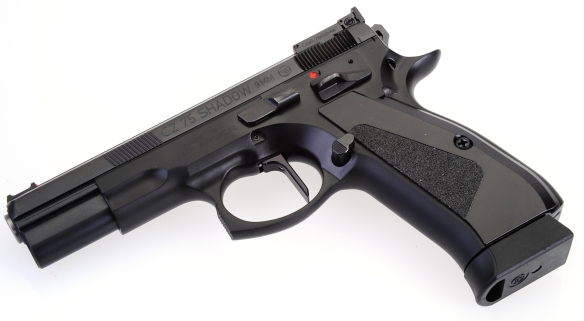
What about that $1,200 MSRP? CZ-USA makes a wide range of autoloaders that start at approximately $400, autoloaders that share a basic design with the Shadow. They make excellent duty guns and fit in well for private citizen concealed carry and home defense and come in many shapes and sizes. The cost associated with the price premium affixed to the CZ 75 Shadow T-SA comes from its hand assembly, custom shop modifications and fitting of related competition pieces. In comparison to competition 1911s from Colt and other leading suppliers, the CZ gun is about half the price. For more information on the CZ-USA line up, including handguns, rifles and shotguns, check out CZ-USA.


Email Notification